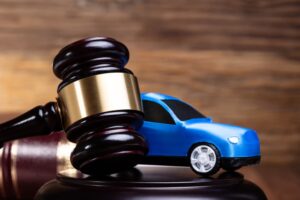Can a Car Accident Claim Be Reopened?

Suppose you sustained injuries in a car accident resulting from someone else’s negligence. In that case, you may be eligible for compensation for various damages, including medical expenses, inconvenience, pain and suffering, and lost earnings. In most cases, the claimant cannot reopen it after signing a release with the insurance company and resolving a car accident claim. However, as with all rules, there are some exceptions.
A knowledgeable car accident lawyer in your area can evaluate your circumstances, file or prosecute a claim on your behalf, and guide you through the necessary steps to recover the full monetary damages you are eligible to receive.
Most Common Causes of Car Accidents and the Injuries that Result
Car accidents can occur due to various factors, with some common causes leading to various injuries. These causes include:
- Distracted Driving — Distracted driving is one prevalent cause, often resulting from activities such as texting, talking on the phone, or adjusting the radio while driving. Such distractions can lead to accidents ranging from minor fender-benders to severe collisions, causing injuries such as whiplash, concussions, or more serious head and neck injuries.
- Speeding — Speeding is another significant cause of car accidents, contributing to a higher likelihood of crashes and more severe injuries. Excessive speeds reduce reaction time and increase the force of impact, leading to injuries such as fractures, internal injuries, and traumatic brain injuries.
- Impaired Driving — Impaired driving, typically involving alcohol or drugs, is a major factor in car accidents. Impaired drivers exhibit diminished judgment and coordination, increasing the risk of collisions. Injuries resulting from impaired driving accidents can range from minor cuts and bruises to life-threatening conditions, depending on the severity of the crash.
- Reckless Driving — Reckless driving behaviors, including aggressive maneuvers, tailgating, and disregarding traffic rules, contribute to accidents with a higher likelihood of causing serious injuries. Common injuries in these cases include broken bones, spinal cord injuries, and severe contusions.
- Fatigue — Fatigue is a less visible but equally dangerous factor in car accidents. Tired drivers may exhibit impaired concentration and slower reaction times, leading to accidents. Common injuries in fatigue-related accidents include whiplash, soft tissue injuries, and head injuries.
- Drowsy Driving — Drowsy driving, often caused by insufficient sleep, can impair a driver’s ability to stay alert and focused. Accidents resulting from drowsy driving can lead to injuries such as whiplash, fractures, and head injuries.
- Inexperienced Drivers — Inexperienced or novice drivers may lack the skills and judgment to navigate various traffic scenarios, contributing to accidents. Injuries resulting from accidents involving inexperienced drivers can range from minor cuts and bruises to more severe head injuries and fractures.
- Weather Conditions — Weather conditions, such as rain, snow, or fog, significantly contribute to car accidents. Reduced visibility and slippery road surfaces can lead to collisions and injuries. Common injuries in weather-related accidents include broken bones, head injuries, and soft tissue injuries.
- Road Conditions and Infrastructure — Poor road conditions and infrastructure issues, such as potholes, uneven surfaces, or lack of proper signage, contribute to accidents. Injuries resulting from these accidents can vary from minor cuts and abrasions to more severe fractures and spinal injuries.
The Steps of Filing a Car Accident Claim
Filing a car accident claim resulting from another driver’s negligence involves several crucial legal steps. The first step is to seek immediate medical attention for injuries sustained in the accident. Prompt, ongoing medical treatment ensures the well-being of the individuals involved and establishes a clear link between the accident and any subsequent injuries.
Following the accident, gathering evidence from the scene is essential. This includes taking photographs of the vehicles involved, documenting the surrounding environment, and obtaining contact information from witnesses. Such evidence is vital in establishing the facts surrounding the accident and can be crucial during the claims process.
Contacting law enforcement to report the accident is the next crucial step. A police report provides an official account of the incident, detailing factors such as the location, time, and parties involved. This report serves as a valuable document when filing a claim, and insurance companies or legal professionals involved in the case may request a copy.
In addition, seeking legal advice from an experienced car accident attorney is advisable before communicating with insurance companies. An attorney can guide the injured party through the process, ensuring they do not inadvertently provide statements or information that insurance adjusters may use against them during the claims process.
Accident victims should also promptly notify their insurance company about the accident, even if the other driver was at fault. Victims should provide insurance adjusters with the necessary information but exercise caution when discussing the details of the accident. Insurance companies frequently use statements against accident victims, so consulting with an attorney before engaging in extensive discussions is crucial.
Victims should also obtain a comprehensive medical evaluation to assess the extent of their injuries. Medical records and bills become crucial pieces of evidence during the claims process. A car accident attorney can collaborate with medical professionals to create a clear and detailed picture of the injuries, their consequences, and the associated healthcare costs.
An attorney will draft a settlement demand letter to the at-fault driver’s insurance company. This document outlines the case facts, the injuries sustained, and a settlement demand. Negotiations with the insurance company follow, where the attorney advocates for fair compensation based on the presented evidence.
If the parties cannot reach a fair settlement, the accident victim’s attorney may file a lawsuit against the at-fault driver. This initiates the formal legal process involving discovery, depositions, and potentially a trial.
Throughout the process, your attorney will represent your interests, working towards obtaining the compensation you deserve for the injuries and damages resulting from your accident.
Limited Circumstances for Reopening a Car Accident Claim
In most cases, after an accident victim signs a settlement release with the insurance company, their claim is formally closed. However, reopening a car accident claim is possible in extremely limited circumstances, contingent upon specific conditions:
- One scenario involves discovering previously unknown injuries or complications related to the accident. If an injured victim experiences delayed symptoms or the full extent of injuries becomes apparent only after the involved parties have settled the initial claim, they may have grounds to reopen it.
- Similarly, evidence of misconduct or fraud by the insurance company or the at-fault party may warrant revisiting the claim. This can include instances where the insurance company or at-fault party misrepresented or withheld important information during the initial settlement negotiations.
- Moreover, if errors or mistakes in the initial claim process lead to an unfair settlement, the injured party can reopen their claim. This can encompass issues such as miscalculating damages, inaccuracies in medical reports, or misunderstandings regarding fault.
- In cases where the at-fault party’s insurance coverage was insufficient to cover the victim’s actual damages, the injured party may be eligible to reopen the claim to seek additional compensation. This situation often arises when the true extent of medical expenses or lost earnings becomes evident after reaching the initial settlement.
- In addition, a significant change in circumstances, such as the development of a long-term disability or the need for extensive ongoing medical treatment, may justify reopening the claim. Changes in the accident victim’s life situation or health condition that were not foreseeable at the time of the initial settlement may warrant a reevaluation of the compensation amount.
While reopening a car accident claim is generally challenging, limited circumstances such as discovering new injuries, uncovering fraud, fixing errors, insufficient insurance coverage, or significant changes in the victim’s circumstances may provide a basis for revisiting and seeking further compensation. Consulting with legal professionals to evaluate the viability of reopening a claim based on the specific circumstances of the case is crucial.
When Is Litigation Necessary After a Car Accident?
Under various circumstances, litigation may become necessary after suffering injuries in a car accident due to someone else’s negligence. One primary factor is when the at-fault party’s insurance company refuses to offer a fair and reasonable settlement. If the offered compensation does not adequately cover medical expenses, lost income, and other damages resulting from the accident, pursuing litigation may be necessary to seek a just resolution.

Litigation may be the only recourse when parties dispute liability or liability is unclear. If there are challenges in establishing the other driver’s negligence, or if they deny fault, a lawsuit can provide a legal forum to present evidence, testimonies, and professional opinions to establish liability and seek compensation.
In cases where the at-fault driver is uninsured or underinsured, litigation may become necessary to recover damages. Limited insurance coverage may not fully address the extent of the injuries and losses suffered, prompting the injured party to pursue legal action to seek additional compensation.
Determining liability can be complex when multiple parties are involved in an accident. In situations where multiple parties bear liability, litigation may be necessary to actively determine each party’s degree of fault and allocate responsibility accordingly.
Suppose the injured party faces challenges in proving the full extent of their damages, such as long-term medical costs, ongoing rehabilitation, or future lost earnings. In that case, litigation becomes a means to present comprehensive evidence and professional opinions to support the claim for these damages.
When negotiations with the at-fault party or their insurance company break down, litigation may be the next step. Unresolved disputes or a significant gap between the compensation offered and the damages incurred may lead to a legal battle to secure fair and just compensation.
Furthermore, evidence of bad faith on the part of the insurance company, such as unreasonable delays, wrongful denial of a valid claim, or failure to adequately investigate, may make litigation necessary to hold the insurer accountable.
Various circumstances may require litigation after suffering injuries in a car accident due to someone else’s negligence. Whether facing disputes over liability, inadequate insurance coverage, complex multiple-party scenarios, challenges in proving damages, breakdowns in negotiations, or instances of bad faith by the insurer, pursuing a lawsuit may be essential to obtain the rightful compensation for the injuries and losses sustained in the collision.
What are Compensable Damages in a Car Accident Case?
Compensable damages in a car accident claim or lawsuit encompass a range of losses that an injured party may recover through legal proceedings. Types of compensable damages include the following:
- Medical expenses incurred due to the accident, including hospital bills, surgeries, and ongoing treatments, are compensable damages. Thorough documentation, including medical records, bills, and professional opinions, supports the claim for these damages.
- Lost earnings are also recoverable damages, compensating for income lost during the inability to work due to the accident. Documentation of income history, employment records, and professional opinions on potential future earnings contribute to establishing the financial repercussions of lost earnings.
- Likewise, loss of earning capacity recognizes the long-term consequences of injuries on the victim’s ability to earn income. Professional opinions aid in demonstrating the lasting effects on earning potential, considering factors such as the victim’s skills, career prospects, and education level.
- Past and future pain and suffering compensation addresses the physical and emotional distress experienced due to the injuries sustained. Medical records, professional opinions, and personal testimonies play a crucial role in quantifying the extent of pain and suffering.
- Furthermore, the accident victim may pursue inconvenience damages for disruptions to daily life that the accident caused. Instances of inconvenience, such as difficulty in daily activities or adjustments to routines, can contribute to establishing a claim for these damages.
- Another significant category is mental distress, covering the emotional toll resulting from the accident. Anxiety, depression, or post-traumatic stress disorder (PTSD) can be compensable, with documentation such as psychiatric evaluations and counseling records supporting the claim.
- Loss of life enjoyment compensation addresses the diminished ability to engage in and enjoy life’s activities due to various injuries. Personal testimonies, photographs, and records of activities the victim participated in before the accident contributes to quantifying this aspect of the claim.
- Loss of consortium compensates for the strain on familial and spousal relationships that the injuries caused. Testimonies from loved ones and evidence illustrating the effects on relationships enhance this aspect of the claim.
- Lost quality of life damages encompasses the overall reduction in the victim’s quality of life due to the injuries. Personal testimonies, professional opinions, and evidence of the effects on daily activities and pursuits contribute to quantifying this component.
- Surviving family members may pursue wrongful death damages if the accident results in a fatality. Compensation may include funeral expenses, loss of financial support, and emotional distress. Thorough documentation and professional opinions contribute to establishing the damages the surviving family members incurred.
- The victim may seek punitive damages in extreme negligence or intentional misconduct cases. These damages intend to punish the at-fault party and deter similar behavior. Clear evidence of egregious conduct, such as intoxicated driving or intentional harm, strengthens a claim for punitive damages.
Speak with a Car Accident Lawyer in Your Area Today

Ted R. Lorenz, Car Accident Lawyer
If you recently sustained injuries in a car accident, an experienced personal injury attorney will do everything possible to ensure you receive all the compensation you deserve. Your attorney can explore and evaluate your legal options and resolve your case through settlement or litigation in the state court system.
